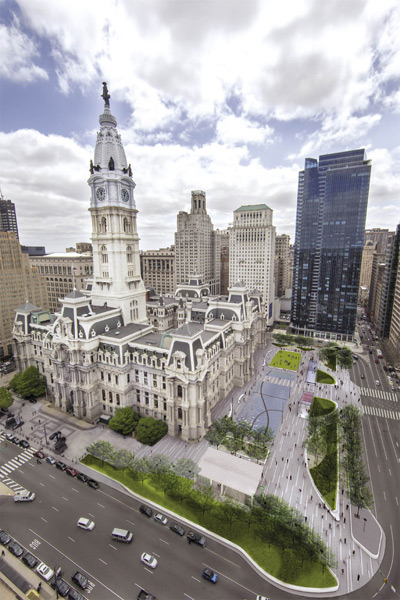How Paul Levy Created Center City
It was 1991 when Levy and the Center City District began proving that point to a dubious Philadelphia public. Back then, few people had heard of such a thing as a business improvement district. The concept had been tried on a small scale in New York, Toronto and some other cities, but the notion of creating an unelected quasi-governmental entity with what amounted to taxing power wasn’t an easy sell to anyone.
But Center City was getting desperate. The suburban malls were paradise compared to Walnut Street in the 1980s—not just for shoppers, but for retailers as well. They were safe. They were clean. And they were run by a single management agency. Center City’s shopping district, meanwhile, was balkanized amongst dozens of property owners, while the public spaces were the responsibility of a confusing array of often inept and perpetually underfunded city departments and agencies. “People were afraid they were really going to lose the downtown, à la Detroit,” Levy says. “One of my mantras is, ‘Philadelphia will continue with business as usual unless we are terrified of something awful.’ And we had the fear then.”
By that time, Levy had acquired an unusual array of skills that prepared him remarkably well for the unusual job of running a quasi-public operation like the CCD. Upon first arriving in Philadelphia, he worked as an activist with Ed Schwartz, a progressive lion and community organizer. From there Levy went into city government with Mayor Green’s administration, working in the Office of Housing and Community Development. His first year in, President Reagan took office, and the department’s budget was whacked 13 percent, giving Levy an early lesson in the limitations of government. For a fleeting moment, he was named head of the Philadelphia Parking Authority, back when it only ran parking garages and had no enforcement function. From there, he bounced to the University of Pennsylvania, assisting in the redevelopment of Walnut Street, and then to the Central Philadelphia Development Corporation, an old nonprofit research and planning outfit that served as the incubator for the Center City District.
Levy knew he couldn’t create jobs or reverse deindustrialization. He wasn’t going to open a restaurant or lower the tax rates. But he could dress the city up a bit, make part of it clean, make people feel a bit more welcome and a bit more safe. “I developed this very simple-headed theory back then that all this stuff about Philadelphia’s inferiority complex didn’t have anything to do with Quakers,” he says. “It was about the squalor. If you walk outside every day and everything is filthy, you internalize it: Nobody cares about this place, it’s worthless, it’s in decline.”
On March 21, 1991, Levy unleashed upon Center City a 100-strong teal-clad army of street cleaners and “community service representatives.” The effect was instant, and profound. Almost overnight, Center City’s sidewalks were scrubbed into something resembling cleanliness. Within weeks, most remaining opposition to the district melted away. Within months, the initiative was a national story, generating coverage in Washington, Chicago, Los Angeles, even Paris.
And everybody knew exactly who was responsible: those guys in the teal jackets and their boss, Paul Levy. “When I’m speaking to districts in other cities, I always say: 50 percent of it is doing the job, the other 50 percent is being seen doing the job,” Levy says.
Twenty-three years on, the district’s mopping and walkie-talkie work seem dull compared to the grand projects it’s tackled, such as Sister Cities Park in Logan Square or the Dilworth Plaza overhaul. Philadelphians today take it for granted that Center City is (mostly) clean and (mostly) safe. But these basics are, even now, the foundation of Levy’s influence. There are a lot of experts out there with ideas for remaking public spaces or tweaking tax policy. Levy gets listened to partly because he’s got good ideas, but mostly because he’s seen as a guy who gets things done.



